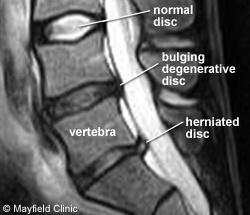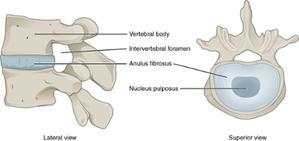Bulged? Herniated? Help!
 It’s an extremely common, and legitimate, concern amongst many patients: is my discherniated bulged disc sciatica herniated or bulged? What’s the difference? The answer often depends on who is interpreting the diagnostic imaging. Symptoms of disc bulges and herniations not only can be similar at face value, they also look very similar to the doctors reading the image. Both can cause sciatica like pain, but are structurally different. Lets take a look:
It’s an extremely common, and legitimate, concern amongst many patients: is my discherniated bulged disc sciatica herniated or bulged? What’s the difference? The answer often depends on who is interpreting the diagnostic imaging. Symptoms of disc bulges and herniations not only can be similar at face value, they also look very similar to the doctors reading the image. Both can cause sciatica like pain, but are structurally different. Lets take a look:
 In order to understand what happens in either case, you first need to know just a bit of the anatomy of an intervertebral disc. The disc is comprised of two main components: outer layers of cartilage called the Annulus Fibrosis, and a gelatinous center known as the Nucleus Pulposus. Together, these components allow the intervertebral discs to act as shock absorbers to your spine. Over time, discs can become bulged or herniated due to acute injuries like a car accident, gym accident, or a fall, or chronic injuries due to poor body mechanics, etc. Injuring the disc requires compressing it in an abnormal way which forces the jelly-like inside to push against the tougher rings of cartilage. The pressure on the Annulus Fibrosis causes a bulge, but the jelly center is still contained within the disc. This is what’s known as a “bulging disc”. In a disc herniation, the pressure on the outer rings of the Annulus Fibrosis is so great that they tear, and the Nucleus Pulposus actually leaks out and can press on the spinal nerves. Depending on the severity of the herniation, the “disc leakage” can be classified as a ‘Protrusion’ or an ‘Extrusion’, the latter being the worse. The treatments can differ for bulges and herniations, but are both based around a good core strengthening program. In severe cases, surgery may be required. Your case should always be reviewed by a doctor who will make the right care plan for your individual goals and needs.
In order to understand what happens in either case, you first need to know just a bit of the anatomy of an intervertebral disc. The disc is comprised of two main components: outer layers of cartilage called the Annulus Fibrosis, and a gelatinous center known as the Nucleus Pulposus. Together, these components allow the intervertebral discs to act as shock absorbers to your spine. Over time, discs can become bulged or herniated due to acute injuries like a car accident, gym accident, or a fall, or chronic injuries due to poor body mechanics, etc. Injuring the disc requires compressing it in an abnormal way which forces the jelly-like inside to push against the tougher rings of cartilage. The pressure on the Annulus Fibrosis causes a bulge, but the jelly center is still contained within the disc. This is what’s known as a “bulging disc”. In a disc herniation, the pressure on the outer rings of the Annulus Fibrosis is so great that they tear, and the Nucleus Pulposus actually leaks out and can press on the spinal nerves. Depending on the severity of the herniation, the “disc leakage” can be classified as a ‘Protrusion’ or an ‘Extrusion’, the latter being the worse. The treatments can differ for bulges and herniations, but are both based around a good core strengthening program. In severe cases, surgery may be required. Your case should always be reviewed by a doctor who will make the right care plan for your individual goals and needs.
 There is a classic metaphor to this that actually makes sense and can help you understand. Think of the disc as a jelly donut. If you press on the center of that donut and the jelly doesn’t squirt out, but just kind of presses against the crust of the donut, that’s a bulge. If you pressed hard enough and the jelly was squeezed out of the donut, that’s a herniation. Moral of the story: don’t lose your jelly! For more information on your case, contact us at (732) 316-5895, or fill out the form below. Now, go enjoy a fresh one! Stay Well.
There is a classic metaphor to this that actually makes sense and can help you understand. Think of the disc as a jelly donut. If you press on the center of that donut and the jelly doesn’t squirt out, but just kind of presses against the crust of the donut, that’s a bulge. If you pressed hard enough and the jelly was squeezed out of the donut, that’s a herniation. Moral of the story: don’t lose your jelly! For more information on your case, contact us at (732) 316-5895, or fill out the form below. Now, go enjoy a fresh one! Stay Well.
-VS